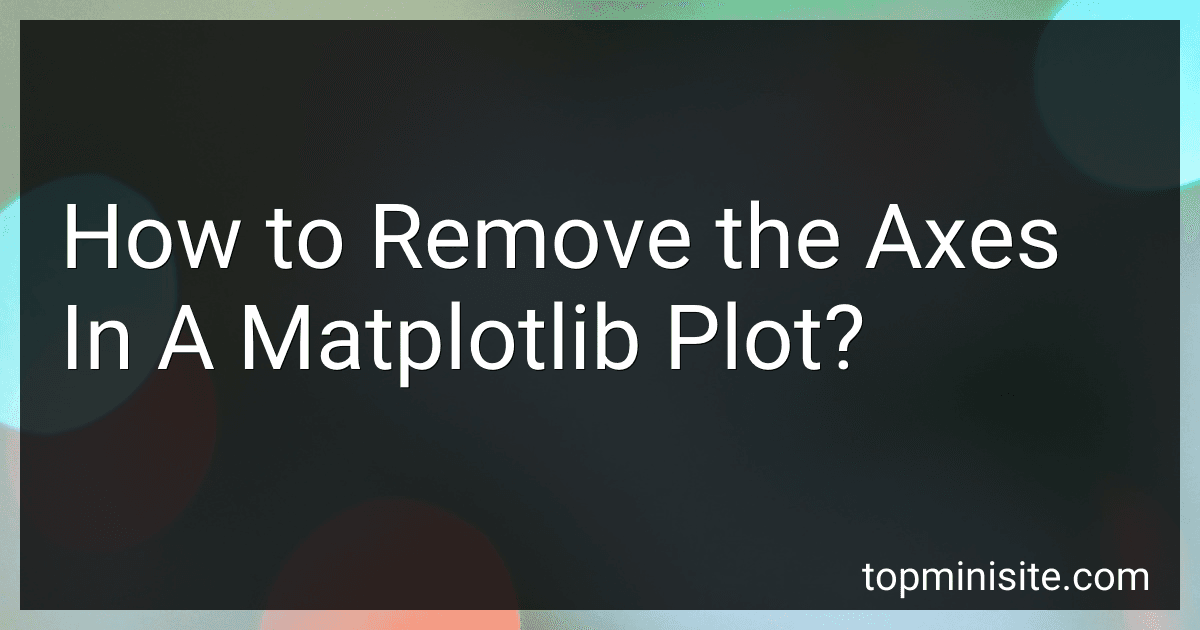Best Tools for Data Visualization to Buy in January 2026

Data Visualization with Microsoft Power BI: How to Design Savvy Dashboards



Good Charts Workbook: Tips, Tools, and Exercises for Making Better Data Visualizations



Fundamentals of Data Visualization: A Primer on Making Informative and Compelling Figures



Data Visualization with Excel Dashboards and Reports



Data Points: Visualization That Means Something



Good Charts, Updated and Expanded: The HBR Guide to Making Smarter, More Persuasive Data Visualizations



Storytelling with Data: A Data Visualization Guide for Business Professionals, 10th Anniversary Edition



Business Intelligence Essentials You Always Wanted to Know: A Beginner’s Guide to BI Tools, Data Analytics Techniques, Data Visualization & Data-Driven Strategy (Self-Learning Management Series)



ColorWise: A Data Storyteller's Guide to the Intentional Use of Color


To remove the axes in a Matplotlib plot, you can use the following code:
import matplotlib.pyplot as plt
Create a plot
fig, ax = plt.subplots()
Remove the axis lines and ticks
ax.axis('off')
Show the plot
plt.show()
Here, the plt.subplots() function creates a figure and axes object. Then, the ax.axis('off') line removes the axis lines and ticks from the plot. Finally, plt.show() is used to display the plot on the screen or in the notebook.
By using these steps, you can easily remove the axes from your Matplotlib plot.
What is Matplotlib and how does it work?
Matplotlib is a popular Python library used for creating visualizations and plots. It provides a way to generate various types of plots, including line charts, bar charts, scatter plots, histograms, etc., often with customizable features like colors, labels, legends, and more.
The library works by creating a figure object, which serves as a container for one or more axes (subplots). An axis represents a set of coordinate axes for plotting data and can be considered as a rectangular area within a figure. Once the axes are in place, methods like plot(), bar(), scatter(), etc., can be used to plot the data on the corresponding axes.
Matplotlib provides a highly flexible and granular control over the appearance of plots. Users can customize various elements such as titles, labels, tick marks, grid lines, legends, colors, and styles to enhance the plot's visual representation. It also allows incorporating mathematical expressions, adding text annotations, saving plots in different formats, and supporting various data formats.
Overall, Matplotlib is a versatile and powerful library that provides an extensive toolkit for data visualization, making it widely used in scientific computing, data analysis, and other domains.
What is the difference between 2D and 3D plots in Matplotlib?
The difference between 2D and 3D plots in Matplotlib lies in the number of dimensions they represent.
- 2D plots: These are the traditional plots commonly used to represent data in two dimensions. They consist of two axes, typically x and y, and visualize data points on a flat plane. Common 2D plots include line plots, scatter plots, bar plots, etc.
- 3D plots: These plots extend the concept of 2D plots by including an additional axis, usually the z-axis, to represent the third dimension. They are used when the data has three variables or dimensions. 3D plots can represent data points in a 3D space, allowing visualization of relationships and patterns between these variables. Matplotlib provides several types of 3D plots, including surface plots, contour plots, scatter plots in 3D, etc.
How to add labels to the axes in a Matplotlib plot?
To add labels to the axes in a Matplotlib plot, you can use the [xlabel()](https://topminisite.com/blog/how-to-add-labels-to-the-x-axis-and-y-axis-in) and ylabel() functions. These functions accept a string parameter that specifies the label for the x-axis and the y-axis, respectively.
Here's an example of how to add labels to the axes:
import matplotlib.pyplot as plt
Generate some data
x = [1, 2, 3, 4, 5] y = [2, 4, 6, 8, 10]
Create a figure and axes
fig, ax = plt.subplots()
Plot the data
ax.plot(x, y)
Add labels to the axes
ax.set_xlabel('X-axis') ax.set_ylabel('Y-axis')
Display the plot
plt.show()
In this example, we first import the matplotlib.pyplot module. Then, we generate some data for the x and y-axis. Next, we create a figure and axes using the subplots() function. We plot the data using the plot() function of the axes object. Finally, we add labels to the x and y-axis using the set_xlabel() and set_ylabel() functions, respectively. The plt.show() function is used to display the plot.
What is the purpose of axes labels in Matplotlib?
The purpose of axes labels in Matplotlib is to provide clear and concise information about the values represented on the x and y axes of a plot. These labels help in understanding the nature of the data and the scale of the plot. They also assist in communicating the meaning of the plot to the audience and make it easier to interpret the plot accurately. Axes labels typically provide a brief description of the data being represented on each axis, along with the units if applicable.
